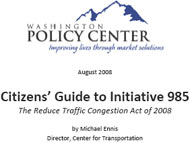Article from: www.thenewspaper.com/news/25/2525.asp
9/5/2008
Washington Think Tank Gives Thumbs Up to Traffic Reduction Measure
Washington Policy Center report finds Initiative 985 would reduce congestion.
 A Washington state think tank issued a report last week exploring the potential congestion reduction benefits of Initiative 985 (view initiative text). The Washington Policy Center, a free-market policy analysis group covering a wide range of state issues, concluded that the measure which is up for voter approval in November could contribute significantly to reducing delays experienced on the state's roads. It also found that the needed reforms had to be made through the referendum process because lawmakers were reluctant to tackle the issue.
A Washington state think tank issued a report last week exploring the potential congestion reduction benefits of Initiative 985 (view initiative text). The Washington Policy Center, a free-market policy analysis group covering a wide range of state issues, concluded that the measure which is up for voter approval in November could contribute significantly to reducing delays experienced on the state's roads. It also found that the needed reforms had to be made through the referendum process because lawmakers were reluctant to tackle the issue.
"During the 2008 legislative session, two bills were proposed that would have elevated congestion relief in the list of state priorities, but neither received a hearing," the think tank's Center for Transportation Director Michael Ennis wrote. "Initiative 985 would seismically shift the State’s current policy back toward one that ties spending to a specific performance goal, traffic congestion relief."
The Washington Policy Center documented a typical monetary diversion in July. Officials took $156,000 raised from a tax imposed on motor vehicles and used the cash to fund a lobbying group known as the Transportation Choices Coalition. This activist group, in turn, lobbied for higher taxes and more subsidies for mass transit. The center's report explained how I-985 would restrict the uses of certain transportation funds for transportation uses. Over the next ten years, it would generate an estimated $1.7 billion for congestion reduction without any new taxes or other fees. This money would then be used to fund the synchronization of 4500 traffic signals statewide at a cost of $41.9 million. The state auditor would be responsible for creating performance measures to ensure that any changes made are actually reducing traffic delays. The auditor has already estimated a seven percent overall reduction from synchronization alone.
The initiative could also spend $3.1 million to expand the state's roadside assistance force which already responds to 48,000 traffic incidents each year. This amount would expand response capacity by up to twenty percent. According to the state auditor, traffic collisions account for about one-quarter of road delays. Additional roadside support capacity would reduce the amount of time needed to clear the road by about ten percent. Another provision of the initiative would stop the diversion of $100,000 in transportation funding used on "art projects."
Initiative 985 also takes aim at the revenue generated by red light cameras and speed cameras. According to the state's Office of Financial Management, twelve cities will generate $39,811,094 in revenue by 2013 with these systems. Cities would be prohibited from keeping this revenue or distributing it to private companies who offer for-profit ticketing services.
"City officials are likely to claim this would create a funding hole in their budgets, which would have to be filled from other revenue sources," Ennis wrote. "Yet, cities should have never planned on revenue in the first place, because their entire objective is to reduce traffic violations to zero, which would also eliminate revenue. As a result, governments, including the state, should never rely on traffic camera safety programs to pay for themselves or to cover other important public services."
After Tim Eyman and his colleagues succeeded in lining up 290,000 signatures to secure the initiative's place on the November ballot, the cities of Aberdeen, Longview, Mill Creek, Wenatchee and Yakima canceled plans to install the systems.
Because the center is an advocate for toll roads, it finds fault with Initiative 985 for effectively destroying the claimed benefit of High Occupancy Toll roads. The provision that opens up HOV lanes to general purpose use would prohibit the imposition on tolls on those lanes for 18 hours of the day. This prohibition would increase capacity and reduce congestion, unlike HOT lanes. TheNewspaper's analysis of a forthcoming HOT lane project in Northern Virginia shows that contract provisions are often specifically designed to generate congestion in order to encourage maximum use of the tolled lanes (view details). The initiative also would prohibit any toll revenue from being diverted to any purpose beyond the improvement of roads or congestion reduction.
A copy of the report is available in a 350k PDF file at the source link below.
Source: Citizens Guide to Initiative 985 (Washington Policy Center, 9/5/2008)
Permanent Link for this item
Return to Front Page
 A Washington state think tank issued a report last week exploring the potential congestion reduction benefits of Initiative 985 (view initiative text). The Washington Policy Center, a free-market policy analysis group covering a wide range of state issues, concluded that the measure which is up for voter approval in November could contribute significantly to reducing delays experienced on the state's roads. It also found that the needed reforms had to be made through the referendum process because lawmakers were reluctant to tackle the issue.
A Washington state think tank issued a report last week exploring the potential congestion reduction benefits of Initiative 985 (view initiative text). The Washington Policy Center, a free-market policy analysis group covering a wide range of state issues, concluded that the measure which is up for voter approval in November could contribute significantly to reducing delays experienced on the state's roads. It also found that the needed reforms had to be made through the referendum process because lawmakers were reluctant to tackle the issue.